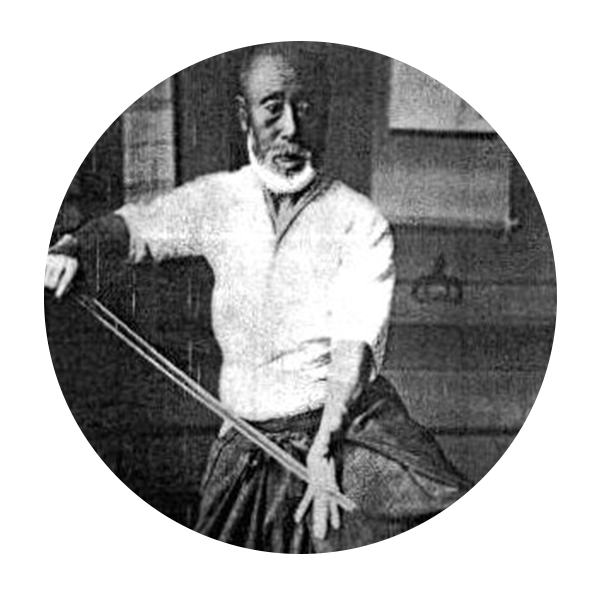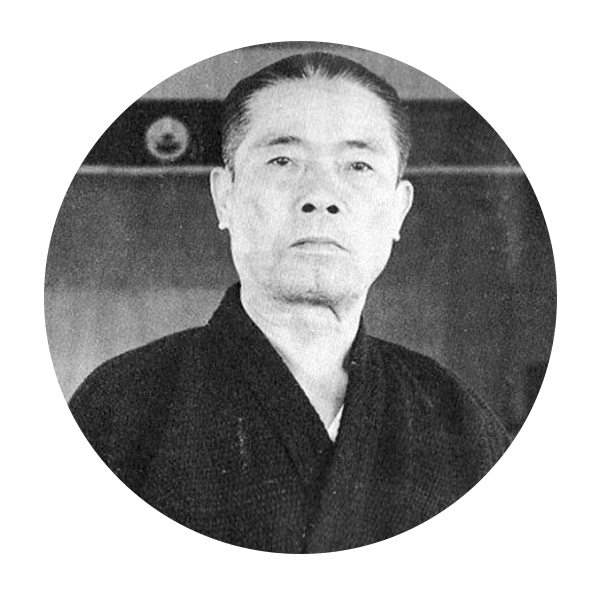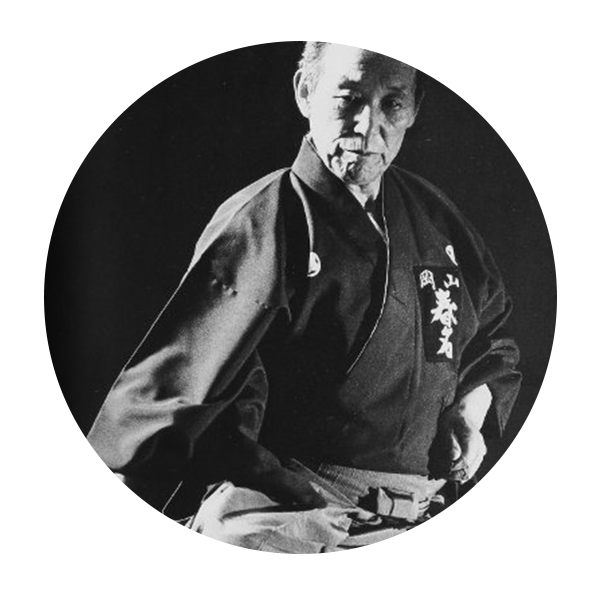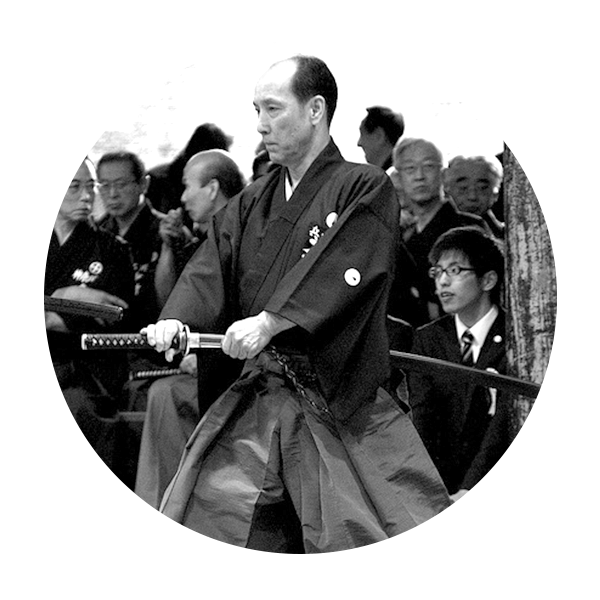Kawagishi’s Lineage
先 (sen) in Japanse means “before”or “precedence”.
生 (sei) means “life” or “birth”.
With the literal translation of both words, we can understand that “sensei” actually means “one who was born before/one who has lived before”.
Kata were created to successfully preserve and pass on techniques, so it is very important for us to remember our lineage so we can continue to practise correct iai.
The lineage that the Kawagishi Dojo follows is called “Muso Jikiden Eishin Ryu”. It’s unbroken lineage can be traced back to the early 16th century. Hayashizaki Jinsuke Minamoto no Shigenobu (1542-1621) is our early founder.
Many historical details are uncertain as, the same was with many famous martial artists, his story has been widely fictionalised.
Souke (宗家) is the Japanese word for “head of the family/house”, and Oe Masamichi was one of the most important souke in our lineage.
After becoming 17th souke for Tanimura-ha, Oe sensei combined the teachings of Shimomura-ha and reorganised the curriculum. The waza were reduced from the original 160 and were grouped into Seiza (shoden), Tachihiza (chuuden), Okuiai (okuden) and kumitachi waza sets which are still practised today.
The techniques remained the same, but the names were changed to assist in understanding.
After the reorganisation, the school was renamed “Muso Jikiden Eishin Ryu”
In the 1900s, he taught kendo and iaido at the Kochi Prefectural Kochi Otemae High School.
In 1924 Oe sensei was the second person (after Nakayama Kakudo) to be awarded hanshi in iaido by the Dai Nippon Butoku Kai
Oe Masamichi(大江正路)
(17th generation headmaster, 1852-1927)
Wikipedia.org/wiki/大江正路
Oe sensei was born in the Tosa province, now know as the Kouchi Prefecture.
During his younger years, Oe sensei studied Kokuri ryu and Oishi Shinkage ryu as well as Shinomura-ha Eishin Ryu (later to be renamed to “Musu Shinden Eishin ryu” by the fourteenth souke, Hosokawa Yoshimasa.)
At the age of 15, Oe sensei participated in the Battle of Toba-Fushimi, after which he began his studies of Tanimura-ha Eishin ryu under Gotou Magobei (16th souke) Eishin ryu boujutsu under Itagaki Taisuke.

Oe Masamichi(大江正路)
(17th generation headmaster, 1852-1927)
Wikipedia.org/wiki/大江正路
Wikipedia.org/wiki/大江正路
Oe sensei was born in the Tosa province, now know as the Kouchi Prefecture.
During his younger years, Oe sensei studied Kokuri ryu and Oishi Shinkage ryu as well as Shinomura-ha Eishin Ryu (later to be renamed to “Musu Shinden Eishin ryu” by the fourteenth souke, Hosokawa Yoshimasa.)
At the age of 15, Oe sensei participated in the Battle of Toba-Fushimi, after which he began his studies of Tanimura-ha Eishin ryu under Gotou Magobei (16th souke) Eishin ryu boujutsu under Itagaki Taisuke.


Yamamoto Harusuke(山本晴介)
(Hanshi 9th Dan, 1893-1978)
Wikipedia.org/wiki/山本晴介
Video 1 Video 2
Yamamoto sensei was born in Gami-kun of Akaoka town in the Tosa Province.
He studied Kendo under Kawasaki Zensaburou, and then began his iai studies directly under Oe Masamichi in 1917.
In 1952, the Zen Nippon Kendo Renmei was established. Yamamoto sensei was of the 12 sensei who helped develop the first 7 kata of what is now known as “seitei”.
Yamamoto Harusuke(山本晴介)
(Hanshi 9th Dan, 1893-1978)
Wikipedia.org/wiki/山本晴介
Video 1 Video 2
Yamamoto sensei was born in Gami-kun of Akaoka town in the Tosa Province.
He studied Kendo under Kawasaki Zensaburou, and then began his iai studies directly under Oe Masamichi in 1917.
In 1952, the Zen Nippon Kendo Renmei was established. Yamamoto sensei was of the 12 sensei who helped develop the first 7 kata of what is now known as “seitei”.

Yamashibu Yoshikazu(山渋吉数)
(Hanshi 8th Dan, 1922-1993)
Yamashibu sensei ran a kendo dojo with his brother Yamashibu Yasuo in Okayama.
In 1957, Yamamoto sensei granted Yamashibu Yoshikazu’s request to become his direct pupil.

Yamashibu Yoshikazu(山渋吉数)
(Hanshi 8th Dan, 1922-1993)
Yamashibu sensei ran a kendo dojo with his brother Yamashibu Yasuo in Okayama.
In 1957, Yamamoto sensei granted Yamashibu Yoshikazu’s request to become his direct pupil.
 /content_band]
/content_band]

Haruna Matsuo(春名松男)
(Kyoshi 8th Dan, 1926-2002)
1994 Interview
Haruna sensei ran the Musashi Dojo in Ohara, Okayama Prefecture where he taught Hyoho Niten Ichi Ryu Kenjutsu, the two-sword style of Miyamoto Musashi.
He began studying the art of Kendo at the age of 16, and began the study of iaido at the late age of 46.
Haruna sensei taught many times outside of Japan; he first entered the UK at age 56, in 1982 and continued to teach and train students in the UK up until 2001.
Haruna Matsuo(春名松男)
(Kyoshi 8th Dan, 1926-2002)
1994 Interview
Haruna sensei ran the Musashi Dojo in Ohara, Okayama Prefecture where he taught Hyoho Niten Ichi Ryu Kenjutsu, the two-sword style of Miyamoto Musashi.
He began studying the art of Kendo at the age of 16, and began the study of iaido at the late age of 46.
Haruna sensei taught many times outside of Japan; he first entered the UK at age 56, in 1982 and continued to teach and train students in the UK up until 2001.

Oshita Masakazu(大下政一)
(Kyoshi 8th Dan, 1948)
KobeGenbukan.com
Oshita sensei, runs the Genbukan dojo in Kobe city, Hyogo. He is also the current instructor of Kobe Gakuin University Iaido Club.
His study of iaido began in 1975 with the Hyogo Eishinkai, and in 1979 he then began to study under Haruna sensei.

Oshita Masakazu(大下政一)
(Kyoshi 8th Dan, 1948)
KobeGenbukan.com
Oshita sensei, runs the Genbukan dojo in Kobe city, Hyogo. He is also the current instructor of Kobe Gakuin University Iaido Club.
His study of iaido began in 1975 with the Hyogo Eishinkai, and in 1979 he then began to study under Haruna sensei.
 /content_band]
/content_band]
